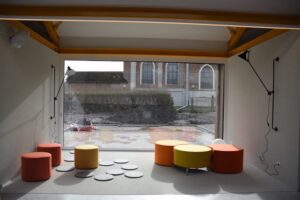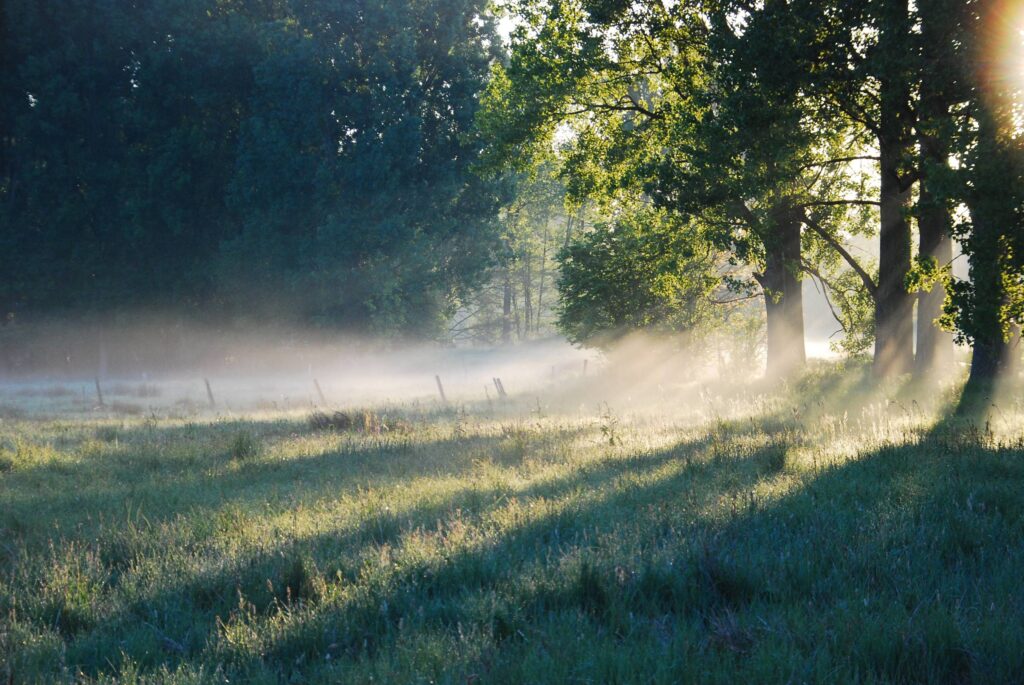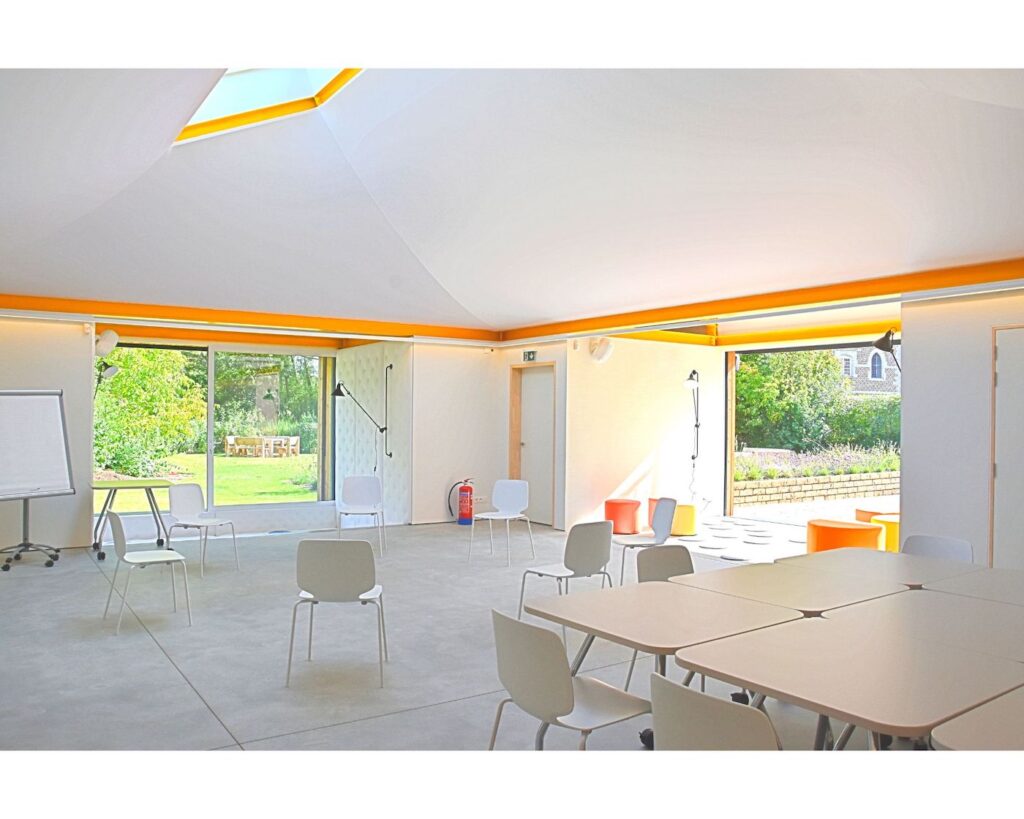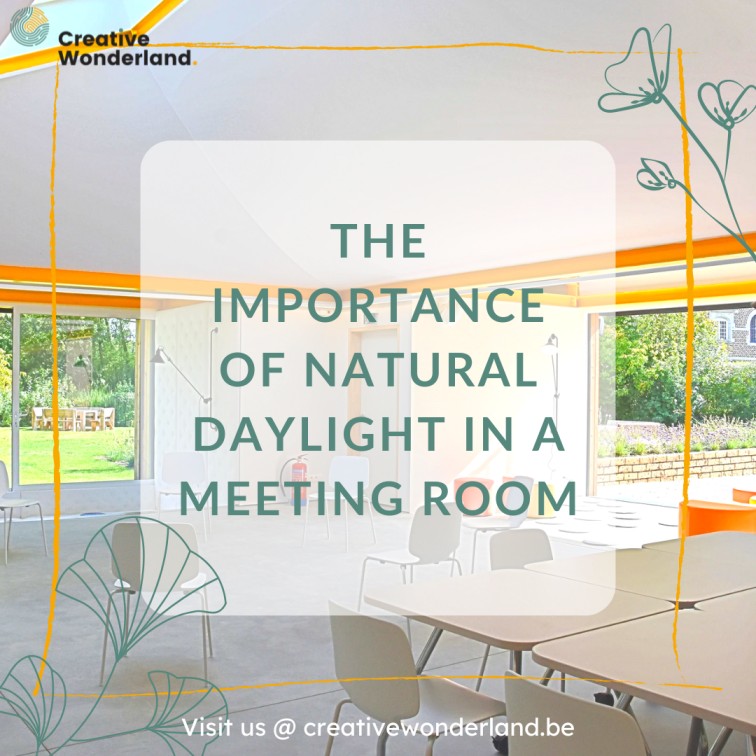“Morning has gold in it, but I didn’t notice much of that gold for the first 15 years of my life,”[1] wrote Dutch behavioural biologist and author Maarten ‘t Hart. In my case, make that 46 years and counting…. That statement really hit home for me… I have a notorious morning mood, and still really need a cup of coffee before I am vaguely approachable (and even then…). Especially in the dark, cold winter months, we snooze diligently before rolling out of bed. As humans, we have come a long way from living according to the cycle of the sun and the seasons, to the rhythms of nature. Natural daylight in a meeting room: why does it matter?
Since the second industrial revolution and especially with the invention of the light bulb, artificial lighting was introduced in many homes. At first glance, this was a positive evolution from the twilight or petroleum light commonly used at the time. Because we were no longer dependent on sunlight, we could get up even when it was still dark outside (the horror…), and go to sleep whenever we felt like it. The sky is the limit!
But we have thus moved further away from our natural rhythm dictated by nature. Has this evolution created growth in the economy, profits for entrepreneurs and further standardization and flattening of education and careers, among other things? Yes indeed. Overall, has this evolution worked out positively for us as natural human beings and for Mother Nature? Not so much.
What is natural daylight anyway?
What is daylight anyway? Daylight, or sunlight, are electromagnetic rays coming from the sun. Sunlight is unique at any time of day. It changes due to many factors such as: reflection and filtering by the earth’s atmosphere, your geographical location, the season, time of day, weather conditions and many more. A full spectrum that currently cannot be replicated by any form of artificial light. So it seems only logical that we, as humans and part of nature, feel most optimal when we are in frequent contact with direct sunlight.
What is the effect of natural daylight on our bodies?
The natural cycle of day and night primarily affects the production of the body’s own hormones or neurotransmitters in the brain. Our internal biological clock strives to synchronize our own rhythm with the day-night rhythm of nature. Because this gave us the greatest chance of survival. Different neurotransmitters are produced at different times to achieve this effect. The most important hormones are serotonin, cortisol and melatonin.
Serotonin
Sunlight, for example, stimulates the production of serotonin. This hormone has primarily a stimulating effect. And not in a stressful, caffeine-like way. Among other things, it makes you feel calmer, more positive and increases your focus. It also affects memory function, self-confidence and even appetite. Its production is highly dependent on daylight intensity and colour.
Less sunlight in winter and consequently reduced serotonin production is said to be one of the causes of seasonal depression. Not for nothing is measure No. 1 for (seasonal) depression: a half-hour walk in nature every day, and preferably at a fixed time. Furthermore, a lack of natural light also leads to a lack of focus, anxiety, and fatigue. Afternoon slump? A walk can do wonders.
Cortisol
Cortisol is another important hormone, often called our stress hormone. This hormone is important for waking up. About 30 min after getting up, your cortisol should reach a peak level. So that you can start your day properly awake and alert. This is ideally the time to expose yourself to natural sunlight to optimize this process. Normally, your cortisol levels gradually drop throughout the day so that by evening you are left with less and less energy. Which is just the point since it is quietly time to sleep.
Research has shown that children in classrooms with little daylight are less alert and have disturbed cortisol levels. Which not only has an impact on how happy a child is at school, but can also potentially lead to less concentration, poorer sleep quality, disrupted body growth, difficult behaviour and higher absenteeism.
Melatonin
At night, the hormone melatonin takes over. Melatonin makes us sleepy at night and ensures a good quality night’s sleep. Lower melatonin is also the reason why we are naturally less active in the fall and winter months. Not for nothing do many animals hibernate in winter.
Especially the production of melatonin is greatly disturbed by the use of artificial lighting and especially the blue light produced by screens of all kinds. But also a late fitness session, that last cup of coffee or a late meal with a glass of wine prevents melatonin from doing its job properly. Too bad, because quality, healthy sleep is the basis of everything and important to feel healthy and fit.
Vitamin D
In addition, daylight also stimulates the production of vitamin D, a vitamin essential for the structure of our bones but also for our immune system, among other things. Thus, daylight not only makes for happy but also healthy people.
In summary, daylight exposure has a very strong influence on mood, brain function, alertness, performance and sleep.

Figure 1: The importance of daylight[2]
One message: enjoy the benefits of natural daylight more often
Nature is so ingenious. 150 years after the invention of the light bulb, we still haven’t found artificial light that can even vaguely approach natural daylight. So in this case, the easiest and most obvious solution seems to be in reverting to what we have always done: enjoy what nature has to offer, in all its light and beauty.
1. Take advantage of the morning light

Exposure to morning light orchestrates the merge between cortisol and melatonin. Upon awakening, you still have a residue of melatonin in your system and cortisol production is not yet optimal. In other words, you still feel sleepy and the snooze button on your alarm clock thus does become very attractive… By going outside within the hour of waking, both hormones are optimally aligned. Even if it’s cloudy.
So get outside – drink your coffee on your patio with the sun on your snout or take a walk with the dog. Ride your bike to work, get off the bus/tram/train one stop early, park your car at the other end of the parking lot, take the kids to school on foot…. You feel more awake, it’s good for your health and for the environment. Win-win-win!
2. More natural daylight makes for a better mood

Daylight stimulates the hormone serotonin, our happiness hormone. So if you’re having a dip, can’t get out of something, your thoughts keep wandering, feel anxious or stressed for some reason: take a walk. Preferably in nature, in the sun. The production of serotonin does not depend on temperature, but on the amount of sunlight. So, winter or summer, get outside. And can’t get outside? Then sit by the window for a while; even in a meeting room you can benefit from natural daylight.
3. Reset your biological clock

Even during the day, your biological clock is busy synchronizing with nature’s. So exposure to daylight during the day also remains important. But again, the possibilities are endless, provided some creativity… Look for those spaces with large windows. Introduce the concept of walking meetings. Or deliberately choose a meeting room with natural daylight. Have lunch outdoors and walk to your favourite coffee shop or lunch spot. Take a walk around the local city park. And making calls while walking is also possible because of that smartphone….
A leisurely evening walk is also a good idea. The waning sunlight during the evening signals to your brain that your body is allowed to rest. Your body will thus prepare itself for a refreshing sleep. As long as you don’t plop down in the couch afterwards with a glass of wine, scrolling on your smartphone….
4. Windows, view on nature

And when you finally settle behind a window, I hope you have a view of nature. Which is also absolutely the reason why we resolutely chose large windows with a view of nature in our meeting room. Natural daylight in meeting room Create with a view of nature; a breath of fresh air.
When it comes to the effect nature has on our minds, we refer to the concept of nature as a restorative environment. A concept studied and introduced in 1989 by Kaplan & Kaplan in their book “The Experience of Nature – A Psychological Perspective.” The study addresses the concept of mental fatigue, a state of mind in which people are so mentally tired that they can barely function. A cluttered and confusing environment appears to be one of the main causes of mental fatigue. Nature offers rest and recovery. And to end with a quote from Friederich Nietzsche, “All truly great thoughts arise from walking.”
The importance of shadow
We have so far focused on how to maximize our exposure to natural daylight. But we cannot ignore the opposite of light, namely shadow.
Nature always seeks balance, just as the human body is always working toward a point of homeostasis. A system where both heat and cold are important, as are water and drought, light and shadow. With a few exceptions, in nature there is shadow everywhere. So a brightly lit room is not optimal.
Imagination and daydreaming, 2 activities essential for your sanity and creative thinking, need shadow and darkness in addition to light. If everything is bright and clear to you, there is no room for imagination, for dreaming about alternatives. Soft, natural light with a touch of shadow and unlit surfaces create a dreamy atmosphere, perfect for brainstorming. Just like those early mornings, full of fog, where the world seems more magical and dreamier and the harsh reality of everyday life is still far out of sight.

In addition, a creative session, a team meeting or a gathering with friends or family also requires a relaxed and open atmosphere. And that is somewhat at odds with a brightly lit room. Dimmed light helps to become looser, more relaxed.
Natural daylight at Creative Wonderland
After the introduction of electric lighting and the clock, we as humans have come to feel that we are above nature, that we can rule nature. In our conference room, we chose to move just that little bit closer to nature. We therefore put maximum effort into letting natural daylight into our meeting room. Thanks to our large sliding windows (which can be completely opened, which is a luxury these days…) and our skylight, Create is always bathed in abundant daylight. Daylight subtly supported by LED lighting in warm colours. And our large garden with nature reserve behind it is always ready for an invigorating walk.

[1] Ongewenste zeereis, Maarten ‘t Hart, 1979
[2] Anna Wirz-Justice, Debra J. Skene, Mirjam Münch, The relevance of daylight for humans (Biochemical Pharmacology, Volume 191, 2021)

